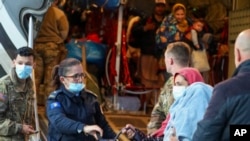Three U.S. government agencies, the Department of Defense, Department of Health and Human Services and the State Department, obligated more than $3.3 billion to support Operation Allies Welcome, the massive evacuation and resettlement of tens of thousands of people from Afghanistan.
Immediately after the collapse of the former Afghan government last August, the U.S. government launched what Secretary of State Anthony Blinken called “one of the biggest airlifts in history” to evacuate at-risk Afghans from Kabul.
The operation was chaotic at times with scenes showing desperate people hanging onto U.S. military planes while they took off from Kabul airport. There was also violence: More than 180 people, including 13 U.S. military personnel, were killed when an Islamic State-Khorasan suicide bomber detonated his explosives at an airport gate.
Recent media reports based on declassified documents obtained through the Freedom of Information Act point to frustration and a lack of coordination between U.S. military personnel and diplomats during the evacuation.
At the end of the two-week exercise, more than 124,000 individuals were safely evacuated from Kabul, according to U.S. officials.
The State Department, which led the operation, paid $37 million for the evacuation flights, which were carried out August 16-31 of last year, according to figures by the Department of Homeland Security (DHS).
U.S. military flights from Afghanistan stopped on August 31, but the State Department has continued evacuating Afghans through chartered and commercial flights.
Afghan evacuees
Many of those evacuated from Kabul were taken to U.S. military facilities in Qatar, where they were screened before being permanently resettled in the United States and other countries. Some evacuees were also taken to Germany and the United Arab Emirates (UAE).
Over 76,000 of the Afghan evacuees have been brought to the U.S., according to a DHS update on February 15.
Still, some of the evacuees remain in transit outside the U.S.
“Several hundred Afghan evacuees were prohibited from immediate onward travel to the United States in order to undergo additional screening and vetting outside of the United States,” reads a DHS situational update from January 16.
Last week, hundreds of Afghan evacuees sheltered at a camp in Abu Dhabi, UAE, protested for three days, calling for their resettlement in the U.S.
A majority of the evacuees who have made it to the U.S. are Special Immigration Visa (SIV) applicants – individuals who worked for the U.S. military in Afghanistan. More than 3,500 of those evacuated last year were U.S. permanent residents.
About 36,000 evacuees did not fall under any of the U.S. immigration programs for Afghans, but still were offered humanitarian parole upon entry to the U.S.
As part of their preparation for settlement, the Afghan evacuees first stayed at eight military installations in the United States. As of February 15, only 1,200 Afghan evacuees were left at Joint Base McGuire-Dix-Lakehurst in the eastern state of New Jersey.
The U.S. has closed its embassy in Kabul and Washington does not recognize the new Taliban government in Afghanistan, but immigration programs for Afghans who worked for the U.S. over the last two decades will continue. In addition to the SIV program, the U.S. announced a so-called priority-2 refugee admission program designated for Afghans last August.
To apply for immigration to the U.S., Afghans will need to travel to a third country where there is a U.S. diplomatic mission.








